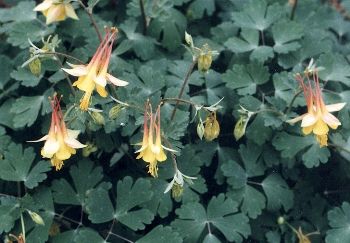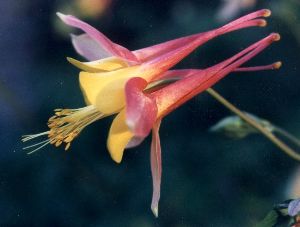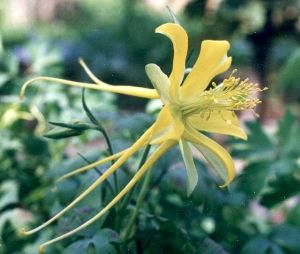Columbines
by Valerie (May 15, 2000)
revised August 14, 2003
 Not usually associated with hot, dry areas, the columbine (Aquilegia sp.) more often brings to mind shady, moist eastern and northern forests or cool, rocky mountain woods. While it's true that some types of columbines (the blue and white mountain variety and the gorgeous purple ornamentals) don't survive hot weather, there are two kinds that do pretty well here. 
The ones that I've always heard referred to as "wild" are the common red and yellow (Aquilegia canadensis) that do grow wild, especially in cool, moist areas. We always had them in our gardens when I was growing up and, as a youngster, it was fun to bite off the five small bulbs on the top part of the flower where the nectar is stored and enjoy the sweet taste. The red columbines that grow here in Texas are similar to those I remember from my youth but are smaller and more compact. They propagate easily from seed and we have lots of them growing all over the place, as they seem to thrive in spite of the hot dry conditions. They bloom very early in the spring, but the foliage looks nice all summer.
The columbines are one of the first plants to really put on a colorful display in the spring. The foliage never freezes back, but stays low to the ground during the winter. In early spring, long stems grow above the clumped leaves and the buds form on the branched ends. Depending on the amount of moisture and the temperature, the blossoming can last for several weeks, with the blossoming stems finally dying as it gets hotter. Many bees and other insects are drawn to the flowers, but the most noticeable are the bumblebees. They can fly during cool weather which might ground other bees and so take advantage of early blooming plants. The shiny black seeds of the columbines are easy to disperse once the pods dry out and they tend to germinate readily. The two species in our gardens have recently started to hybridize, producing plants with flowers that range from almost all yellow, to pink and yellow, to mostly red but with the shape of the yellow ones. Each plant seems to be different, but the flowers are consistent on any particular plant. |
 The yellow variety is used quite a bit in gardens in this area and is called Texas gold (Aquilegia chrysantha). The shape of the flowers is much more spider-like and graceful than the other kind. We have had a large plant for almost fifteen years, but it seems to be dying back a little more each year. The seeds have never germinated unless cross-pollinated by the red flowered plants. It still has a lovely mass of flowers every spring and the bees seem to relish it.
The yellow variety is used quite a bit in gardens in this area and is called Texas gold (Aquilegia chrysantha). The shape of the flowers is much more spider-like and graceful than the other kind. We have had a large plant for almost fifteen years, but it seems to be dying back a little more each year. The seeds have never germinated unless cross-pollinated by the red flowered plants. It still has a lovely mass of flowers every spring and the bees seem to relish it.